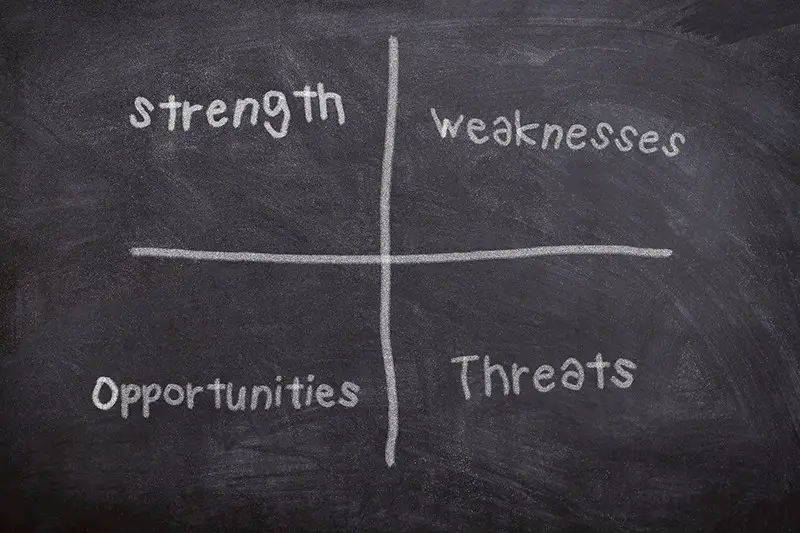Click here to get this post in PDF

Today, we propose to consider what a SWOT analysis is, as well as the definition and methods of its implementation. After all, every business must constantly adapt to changing market conditions and trends. But, before changes, it is worthwhile to study your enterprise and analyze some important aspects of the functioning of departments. Without quality planning and data collection, you will not be able to figure out which direction to move and how to avoid unnecessary cost increases. With the help of a set of marketing actions, you can make decisions about the future of the entire organization. Let’s study this term in more detail and learn how to work with it.
SWOT: What it is and what it means
Some entrepreneurs choose not to do this kind of research. As a result, their companies often stagnate or begin to seriously lose in revenue because the product that was at the peak of demand two years ago is no longer of interest to buyers. If the head of such a company spent a little time and studied what is happening at this moment around the enterprise, then he or she would not be on the brink of ruin.
The SWOT analysis consists of four directions, according to the first letters of which they made the name of SWOT:
- S – strengths in which the company can be confident.
- W – weaknesses, which should be corrected and remembered.
- O – opportunities, which are worth developing in order to increase profits.
- T – threats in which it is necessary to minimize their impact or get rid of them, if possible.
It may be time-consuming to create a SWOT analysis, especially if you haven’t done it before. If you want to save time, special writing services like WriteMyEssayOnline can help you. You can order an analysis sample to see how to compose your own. To learn more about the service, take a look at this WriteMyEssayOnline review.
4 features of a SWOT analysis
As we said above, there are four main areas that any business should investigate.
S – strengths
These are factors that have a positive effect on the development of the company. This usually includes anything that turns normal functioning into successful and competitive work. These are all the advantages and benefits.
You can consider the following:
- the fame of the brand
- reputation
- range
- the quality of goods
- the convenience of the location for the office or store
- customers, a wide base
- well-thought-out and functioning bonus system
- the level of service
- professional staff
These are just some of the items that can be considered in this group. It is worth considering and including anything that makes an organization attractive to buyers.
W – weaknesses (negative qualities)
By analogy, these are the aspects of the internal environment that hinder development, restrain economic growth, and negatively affect the company’s reputation. These are usually internal factors.
In a SWOT analysis, the weaknesses of the enterprise are considered:
- overpriced goods or services
- lack of a budget for marketing activities
- staff turnover
- too low or high salaries of staff
- working conditions not meeting the requirements for the job description
- poor representation in the market
- managers not understanding their work
- the sales department being unable to cope with the tasks
- bad or damaged reputation
- low or questionable product quality
- minimum assortment (not for everyone)
There can be more negative points, but it all depends on the sphere in which the company operates. For example, if you don’t have your own vehicle fleet, then delivery will be slow. But if this is a company that sells the creation of sites, then they do not need trucks, and this will not be relevant.
O – opportunities (development areas)
These are environmental factors that, if used correctly, will unleash the potential of the organization. These are the nuances that managers need to be aware of but not show to competitors yet. All this is prepared for a long time, and then it is used.
What this includes:
- the likelihood of working abroad – access to unexplored or foreign markets
- opening a new direction – capturing new niches, rapid expansion
- a competitor left a niche – you can take advantage of this and develop a product
T – threats
The negative factors of the external environment of the firm are considered here. This block should reflect all the risks that will complicate the company’s activities, slow it down, and reduce revenue.
This consists of:
- price competition – a new entrant dumps or offers goods at a compromised cost
- difficulties with suppliers – they do not provide the required products or do it out of time
- raw materials are growing in cost
Conclusion
This type of research is a versatile tool that helps analysts figure out which direction to move and what to fear. If carried out regularly, the result will bring a noticeable improvement in the firm’s position and increased profits. Do not forget that having writing skills is also necessary when compiling a SWOT analysis so that the analysis can be understood by others. If your writing skills are weak, then this ultimate writing guide will help you improve them.
You may also like: 5 Tips for Entrepreneurs
Image Source: Pixabay.com
